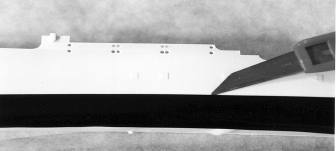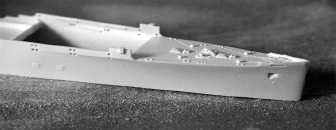Noel Ray (noelray@iol.ie)
Again, nothing much on civilian plastic ship kit horizon in the
near future. Slightly off-topic, but interesting nevertheless, REVELL-GERMANY
is reported to have released the USS Indianapolis, while REVELL-MONOGRAM
is offering the Confederate States Steamer (CSS) Alabama (1:96) which
was a celebrated steam and sail sloop of the US Civil War. The latter
is an expensive kit retailing for $65.50 in the USA. However, Joel Labow
of the on-line Ship Models Mailing List writes: "...the Alabama... appears
to be a rough and ready adaptation of (the) Kearsarge (kit) which bears
only a passing resemblance to the Alabama drawings available on the University
of Alabama website". Some further material, together with high quality
scratch-built model photos, is available at the website of The Model Shipyard
(Stephens & Kenau), Mossel Bay, South Africa. While on the subject
of the internet, Felix Bustelo has photos of just about every liner model
released in plastic on his website. This is a useful resource to check
what has been available over the years but, caution, not everything is
currently in production! Addresses for all these websites are the end
of this article.
Rumour has it that MINICRAFT is considering a range of injection-moulded
liner kits in 1:600 scale. However, it appears that liners are one of
the most difficult subjects to tool (presumably due to superstructure
detailing etc) and they need all the encouragement they can get! Caroline
Carter of White Ensign Models indicates that the 1:700 resin Aquitania
will happen later this year: "...it will be patterned and cast by Brian
Fawcett, with Peter Hall's photoetched brass details. This will be the
finest kit of a liner ever produced. However, it will be waterline, not
full hull". While the scale is rather peculiar, it will make an interesting
comparison with the AIRFIX 1:600 range. The maritime authority, John Maxtone-Graham,
considers Aquitania to have been Cunard's "White Star" ship due to the
more spacious nature of the accommodation compared to Lusitania &
Mauretania. Incidentally, discussion regarding the potential toxicity
of the resin used in such kits rumbles on but the general consensus seems
to be to adopt sensible precautions when sanding such items (wet sanding
with mouth & nose protection).
A tip this month: waterlining a full-hull plastic model is relatively
straightforward before construction. Forget saws and the like. Since polystyrene
is brittle, rather like glass, it can be cut by a "score & crack"
method - commonly used for cutting sheet material. Use a length of masking
tape to mark the waterline on each hull half (Fig 1). This will act as
a guide for your

FIG 1 - THE WATERLINE IS MARKED WITH MASKING TAPE & SCORED WITH A MODELLING KNIFE
modelling knife - remember to allow a little more in the depth of the hull sides to allow for possible seating in a Plasticene sea and for squaring up the cut afterwards. It's easy to take material off but considerably more difficult to put in on again so err on the side of caution! Use your modelling knife to lightly score the hull along the edge of the masking tape. Follow with one or two more deeper cuts and gently crack the hull away from the cut. As the hull bottom is now missing, the waterlined hull halves are cemented via relevant deck sections. When thoroughly dry, the assembly is rubbed across a flat sheet of abrasive paper until the desired waterline is achieved (Fig 2)

FIG2 - LEVELLING THE WATERLINE ON A
FLAT SHEET OF ABRASIVE PAPER
- checking that the hull sits upright and is not listing! As for a base
on which to mount the model? Hardwood is ideal to prevent warpage - but
some of the very dense chipboard products may be suitable. Ask in your
DIY shop!
The construction illustrated took less than 30 minutes from start
to finish, waterlined & assembled using the self-hardening dental
plastic which I have referred to in a previous issue of the Docking Bridge.
Unfortunately, this material, which is used for constructing temporary
crowns & bridges in the dental surgery, is not available to the general
public but some entrepreneur should develop a similar product for the
hobby industry! Setting is by rapid polymerisation rather than the slow
loss of solvent as with ordinary polystyrene cement.
CSS Alabama (http://www.slis.ua.edu/tgtest/cssala/MAIN.HTM);
The Model Shipyard, South Africa (http://www.gardenroute.org.za/shipyard/frames.htm);
Felix Bustelo (http://members.tripod.com/~febus65/imm.htm);
Ship Models Mailing List (http://www.smml.org.uk/);
White Ensign Models (http://dspace.dial.pipex.com/town/avenue/xdt22).
|
-Help support TRMA by using these links to buy your next Ocean Liner related book |